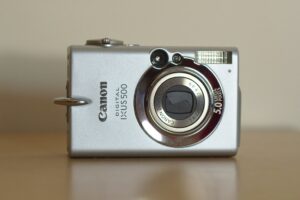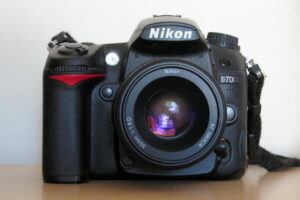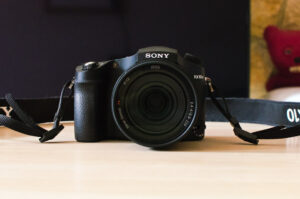Photography has been a hobby of mine since about 2007. I’d taken photos prior to then, but only really snapshots without much thought to composition. So here’s a brief history of photograph as my hobby and the cameras I’ve gone through (you can see more detail on my kit here).
Point and Shoot
My first play with a camera was while I was at uni in 1994 when I borrowed a manual film camera from my mum. It had a metering needle in the viewfinder to help with exposure but I didn’t really know what I was doing – the results were haphazard to say the least. A few years later I bought a nice automatic compact film camera which meant my snapshots were at least properly exposed most of the time but they were still snapshots. I didn’t pay much attention to digital photography when it first took off – it was expensive and I wasn’t really into photography still. As cameras improved and prices came down I eventually, circa 2004, bought a compact digital point and shoot. The Canon Ixus 500, which was decent enough for the time.
It wasn’t until around 2007 that I started to pay a little bit more attention to composition. My partner did have photography as an interest, with a background of having played around with SLRs from a young age as it had been an interest of her dad’s. Her interest and seeing the results she was able to achieve inspired me to think a bit more about what I was doing with the camera. The lack of control over e.g. aperture for depth of field on the Ixus lead me to considering upgrading to something I could do more with, so considered an upgrade. At that point, though, I still wasn’t sure if I was going to be into photography enough to justify getting a DSLR at the time (even with them becoming more affordable), so I decided to start with a bridge camera (so-called because they bridge between point-and-shoot and DSLR) and see how I got on.
My First Bridge
The bridge camera I went for was a Fujifilm FinePix S6500fd. I picked it as it wasn’t too pricey, had manual and priority modes, and seemed to get decent reviews at the time. I made good use of it over the year that followed, photographing cats, cars, wolves, butterflies, family, local carnival, etc etc. The experiences with that camera helped confirm to me that photography was something I enjoyed doing.
The limitations and compromises of that camera did start to become apparent to me over that year and were starting to feel a bit constraining. For example the sensor on it, while OK, was a bit too noisy in poorer light with the resolution of 6 megapixels feeling a little low. It had an electronic viewfinder which was a bit lacking in resolution and quality making it harder to assess the shot. Also the results my partner had achieved with prime lenses with a film DSLR made showed me what was possible with better quality glass with a wider aperture. So I decided it was time to make the plunge and get a DSLR.
My First DSLR
It was a hobby I was enjoying but I still didn’t want to go mad on spending on kit. I didn’t really have a dilemma over which brand to go with – my partner had a Nikon D80 along with a couple of hand-me-down Nikon film SLRs from her dad, so it made sense for me to go with Nikon so we could share lenses. I decided on the modest Nikon D60 with a kit lens to start with. I was aware that the kit lens wasn’t particularly fast though, and having seen the results my partner had achieved with prime lenses I also wanted some sort of prime lens as well. The D60 lacked the in-body drive motor for auto-focus on the older AF-D lenses but the AF-S prime lenses were more than I wanted to spend at that time. Since the Nikkor 50mm f/1.8 AF-D lens was such a good price and so well respected that I decided to go for one despite the fact it would not auto-focus on the D60 and just manually focus it (it would still meter on the D60).
It was a good DSLR to start with and I really liked the quality of the 50mm lens. The D60’s focus confirmation light operated in manual mode as a guide to when the body’s auto-focus detected the subject was in focus which helped with manually focusing with that lens, although it was still tricky to properly nail it compared to using a camera with a focus screen with e.g. a microprism focus aid. Over the next year I got into the hobby more and would end up buying the 35mm f1.8 AF-S lens – partly for the auto-focus capability but also partly as on a crop sensor it’s a more usable length than 50mm – and also an AF-S 18-200mm f/3.5-5.6G VR lens to give me VR and a bit more reach than the kit lens had. I also started making use of RAW mode on the camera and post-processing the RAW files to adjust white balance and have a bit more in the way of options for highlight/shadow recovery.
My main subjects for photographing were cats (I had two and also often fed a friend’s menagerie while she was on holiday), and cars (I visited quite a few car shows/meets). I also took quite a few wolf photos – I was a member of the UK Wolf Conservation trust and visited their open days and went on a wolf walk each year. I easily got into the habit of taking my camera with me when visiting anywhere – just in case there was something interesting to shoot!
Further Adventures in DSLR
The D60 kept me happy for another year but then the D90 came out and tempted me to upgrade. It had much better performance and resolution, as well as an auto-focus drive screw to allow for more lens choice. I found someone who was interested in buying my D60 for a reasonable price and so made the jump to the D90. I also acquired a few more lenses while owning the D90 – finally getting a “walkabout” zoom (Sigma 24-70mm f2.8) and a macro lens (Tamron 90mm) – both AF-D so taking advantage of the auto-focus drive screw – plus I bought some cheap old manual lenses via ebay. Another obvious purchase was a flash (SB-600) to be able to do off-camera flash.
As the D90 was a very capable camera I managed to resist the temptation to upgrade further for another couple of years. Other than jumping to full frame, which wouldn’t be compatible with some of my lens collection and would cost loads more, there wasn’t anything else to tempt me during that time. Then the D7000 then got released. Although the D7000 wasn’t worlds ahead of the D90 it had just enough small improvements for me to get tempted again (e.g. higher resolution sensor with better low light performance, aperture coupling ring to meter on the manual lenses I had, superior AF system, more robust body). A friend was interested in my D90 and so with being able to get some money for my D90 I decided to make the jump.
I used the D7000 almost exclusively for the next 8 years. I had no urge to jump to full frame and the D7100 and D7200 when they came out as they really didn’t add enough extra over the D7000 for me to bother moving to either of those. My feeling was I’d stick with the D7000 until either it broke or, alternatively, I won the lottery and could afford to move over to full frame (a number of my lenses were DX). During that time my two lens acquisitions were mid range zooms as I’d started to do less car photograph and a little more animal photography (birds and also animals at zoos, along with continuing the Wolf Trust visits). The first of those was a Nikon 70-300mm VRII lens. After getting the 24-70mm I really only used the 18-200mm for the long end of the zoom range and the 70-300mm VRII lens was a better complement to the 24-70mm. After a few years the relative slowness of the 70-300mm lens and softness started to niggle so I then bought a Sigma 70-200mm f2.8 EX DG OS HSM lens. Also acquired a couple more flashes (this time Yongnuo YN565EX as they support Nikon’s CLS but is a lot cheaper) plus flash stands and umbrellas.
During that time my main subjects for photography remained cats and cars plus animals during zoo visits, but of course I didn’t limit myself to just those subjects! On one occasion I took a few shots while attending a wedding of a member of my partner’s extended family and it turned out afterwards that the couple were rather disappointed by the results from their official photographer on the day – they were quite pleased I’d managed to capture a few nice moments from the day. I photographed the choir my partner sings in and they used a couple of the shots on their website. A friend needed a portfolio of photos of her son so I had a go at that. I’ve had a go at doing portraits of colleagues for Linked-in profile photos (I’m not very comfortable photographing people though). For a while a car club I belong to had just-for-fun photography competitions each month so I tried to capture something most months to contribute to that (the themes which are set are quite varied, rather than just being car-based). When the local Red Kites which range where I live have been lower in the sky and nearer I’ve tried to photograph them with some success. Most years I popped along to the “Wings and Wheels” event and get some shots of the planes performing aerobatics. With the flash guns I’ve had a go at action photography of my cats, with some of the shots being used to advertise cat toys and I’ve also had a couple of my cat photos used in cat-related books as well. I started to visit Richmond and Bushy parks to try take photos of the deer there. Oh, and it seems I can’t resist taking shots using curved reflective surfaces.
Back To Bridge
The two zooms I’d bought for the D7000 (the 70-300mm and then the 70-200mm) were OK but there were times where I really felt more zoom length would be useful (on the D7000 they were equivalent to 450mm and 300mm respectively on 35mm). I felt the limitation mainly with photographing animals at zoos, deer in the parks and birds while out walking. A body with a higher resolution sensor would allow for closer cropping (i.e. digital zoom) but I wasn’t sure the sharpness of either lens was really good enough for that. One option was a teleconverter for the Sigma 70-200mm, but the 1.4x would probably just result in results not much better than the 70-300mm I had (with light loss and softening), and the 2x would give slightly longer reach but again the trade offs may not be worth it. High quality longer lenses were primes, bulky and very expensive; longer zooms all seemed to be compromised – none of the options appealed.
Bridge cameras had been steadily improving since my first Fuji – advances in sensor technology meant the small sensors they use were actually starting to perform pretty well in terms of resolution, dynamic range and noise despite the smaller sensor sizes – and the small sensor size meant it was easier for the manufacturers to give them a zoom that was quite long in terms of 35mm equivalence. This included some “super zooms” such as the Nikon B700 (1440mm equivalent), the P900 (2000mm equivalent) and the P1000 (with its unreal 3000mm equivalent zoom). I started to wonder if maybe having a super zoom bridge as a companion to my D7000 would do the job to cover when I needed a long zoom.
Having looked at the options my concern was whether I’d find a super zoom bridge frustrating. The quality in terms of sensor noise and lens, the likely relative slow speed of auto-focus and the limitations of stabilisation at those zoom lengths could mean the results would be too hit and miss for my intended purpose. Also the compromises generally in the cameras would mean I could feel frustrated if, while carrying the super zoom, I then found near subjects and didn’t have my Nikon (leading to a temptation to end up wanting to carry both). Finally there was the question as to whether I would I get enough use to justify the spend if it was so compromised.
I kept revisiting the question of a bridge camera from time to time over the course of a few months. One that did keep catching my eye was the Sony DSC-RX10, but I’d dismiss it fairly quickly due to the cost and the max zoom length being a “mere” 600mm equivalent for the most recent two revisions. Still, it seemed to be very well liked, with DSLR owners happily using both the Mark 3 and Mark 4 for wildlife/safari photography and being pleased with the results – perhaps 600mm would be enough. The Mark 4 added phase-detection auto-focus in addition to contrast-detection giving it very quick claimed auto-focus speeds – I decided that if I got the Mark 3 then the thought of not having that could niggle (although the price difference was significant). I decided to keep an eye on Mark 4 prices and continue to weigh it up as an option – perhaps if they released a Mark 5 that would bring down the price by enough.
When doing one of my reviews of prices I noticed several grey importers were quite a bit cheaper. I usually dismiss these as an option as there can be warranty problems (both claiming initially from the seller, generally Hong Kong-based, and also from the manufacturer with longer warranties) so it’s not worth the risk on a more expensive item. However one of the importers had very high TrustPilot ratings as well as reports (which seemed authentic) from people who had claimed on their 3 year warranty successfully. After weighing it up a little longer I decided to take the plunge towards the end of November 2019.
DSLR Neglect
It was perhaps slightly odd timing to buy it as winter approached given the daylight hours are getting shorter, weather grimmer, etc. But a couple of days after it arrived though there was some glorious weather and I went for a long walk around Windsor Great Park to have my first proper go with it. As well as the usual array of autumnal trees, random birds, monuments and plant life I was lucky enough to encounter a lot of deer fairly relaxed and not far from the path (on previous visits there they’ve always been few, distant and skittish). I was really happy with the results from the day!
As of the end of April 2020 it’s now been 5 months since I acquired the RX10. I’ve used it for photographing flowers, swans, geese, my cats, small birds, the moon, red kites, various animals at zoos (Marwell and London). It’s performed so well that I’ve barely used my DSLR, especially with the convenience of not having to carry a set of lenses around as its one lens is pretty good. The 600mm zoom length has proved sufficient – occasionally a little more would be good, although the sharpness at its preferred aperture (f/4.0) means I can close crop a reasonable amount and still have a good quality photo. Another party trick of the Mark 4 is its incredible burst speed with the electronic shutter for continuous shooting – it can manage 24 frames per second with continuous focus and exposure even with RAW. This can help with e.g. further compensating for camera shake (over and above the stabilisation) by maximising the chance of catching a shot at a moment when the camera is steady.
The drawbacks it has compared to the D7000 (and lenses I have for that) are: the aperture limitations mean no shallow depth of field for wide shots, no true macro, low light performance isn’t quite as good, you don’t have to stop down much from its sweet spot of f/4.0 to get softness, battery life, electronically controlled zoom (so less direct and slower than mechanical). I also can’t use my flash setup with it. But for the most part I rarely notice those downsides for my usage and the benefits of the RX10 mean that’s pretty much all I reach for.


